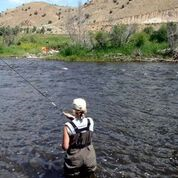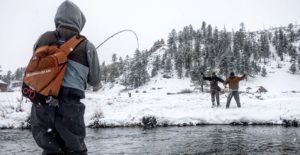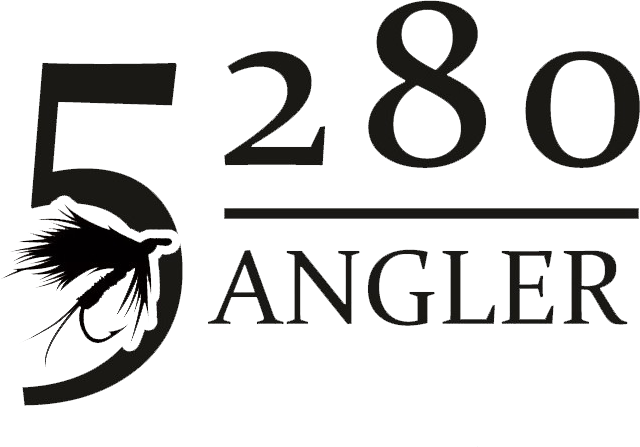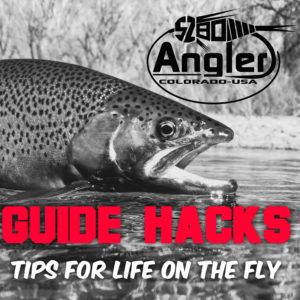GUIDE HACKS – Practical Strategies for Life on the Fly
LEAD > MEND > POINT > A Nymph Fisherman’s Mantra
by Ron Pecore, Senior Guide
This week I want to talk about an essential positioning component to effective nymph fishing.

The key to success I’m referring to is the matter of being consistently in position to make a timely and secure hook set. While guiding guests on the South Platte River, I often notice how some clients will over compensate the mending process throughout the drift..some will throw two or three mega mends, still others more than that. More costly still, some anglers will often dilly dally after the mend. This lag time puts folks (and their rods) out of position to both notice and make the hook set when it counts. Fly fishing is hard enough, we anglers don’t want to put ourselves at any disadvantage as it relates to the moment a fish takes our fly!
Watching an experienced angler last season, I told him, “Man you are the best mender I have ever seen. But did you see that strike?” His response…”not at all.” I think this story illustrates my point. Mending is a means to an end, not an end in itself. It’s possible that some of this over emphasis on mending is related to how many anglers have learned to fly fish by taking a guided trip in a drift boat, where ongoing mends are more appropriate given the width and depth of the water, as well as the typically longer duration of a drift. There’s just a lot more line out during that situation. Alternatively, in most Front Range nymph fishing situations, very little line is needed to present our fly patterns to fish. It’s really just a matter of making a transition with our line control mentality.
To me, line control is more a matter of efficiently managing a drift in preparation for a hook set. The latter part is critical. When nymph fishing, it’s all about getting into position to STRIKE (aka set the hook and close the deal).

TIMELY HOOK SETS RESULT IN BENT RODS!
I am more focused on coaching my guests to become the best strikers on the river, than I am worried about leading them to make perfect mends. As a matter of fact, I start teaching new anglers with the hook set, before I teach them about a mend. Though both are important, I want the notion of ‘SET THE HOOK’ to be at the very forefront of every angler’s mind. It’s about being prepared to strike, as soon as a rig hits the water. It’s about getting into what I call, “strike position” and managing line to stay at the ready to pull the trigger.
I break strike position down with three key concepts: LEAD. MEND. POINT. I’ll explain below.
LEAD
The first key word to remember is ‘LEAD.” To clarify the term as it relates to hook set readiness, visualize yourself at the end of a roll cast upstream. As soon as your nymph rig hits the water your casting arm is moving the same speed that your indicator is drifting. By moving your arm this way, like a shotgun barrel following the bouncing bubble, there should be a relatively straight line from the rod tip on through to the indicator. You may have to use your other hand to strip in a little line as it is drifting downstream. Alternatively, raise your arm as the indicator drifts nearest to you, and lower as it moves away (forming almost a rainbow like arc with the rod tip) This LEAD with the rod/arm puts you in a perfect strike position to set the hook in a quick downstream tug. But most importantly you are now ready to strike rather than mend. Remember this is your number one job.
MEND
Now when your drift floats past your shoulder, this is when you throw your first “MEND.” Adjust your line quickly so you can get right back to your lead position. (Note: I am purposefully under-describing this component…).
POINT
I call this final position ‘POINT.’
As soon as you mend, you quickly point your rod slightly downstream of your indicator. Once again this puts you in the perfect strike position. Don’t delay. Admiring the mend is not as cool as admiring a beautiful Rocky Mountain trout. Get that rod back downstream to where you’re at the ready if a fish decides to sip your bug.
Remember, flies are not scented, and they don’t taste good to trout. They will spit em out faster than a toddler spits out vegetables. THAT is why you need to stay in strike position: Lead > Mend > Point.

Get in position, stay in position, catch more fish!
Give it a try the next time you hit the river. If it leads to more hook sets, you’re on the right track, and likely hooking more fish.
Ron developed his precision reaction skills while training as a professional table tennis player (truth).
Although “Mend it to bend it” has become a popular expression amongst the kids, Ron believes “Set it to bend it” is where it’s at.
Want to have Ron coach up your drift, and show you a whole lot more out on the water? CONTACT US today to book your guided fly fishing adventure!


